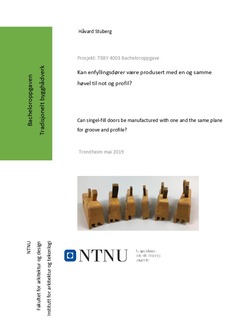| dc.contributor.advisor | Heiberg Thor-Aage Kaminka | |
| dc.contributor.advisor | Jarle Hugstmyr | |
| dc.contributor.author | Stuberg Håvard | |
| dc.date.accessioned | 2019-09-05T14:03:23Z | |
| dc.date.available | 2019-09-05T14:03:23Z | |
| dc.date.issued | 2019 | |
| dc.identifier.uri | http://hdl.handle.net/11250/2612811 | |
| dc.description.abstract | Sammendrag
Som snekkere flest med interesse for gamle arbeidsteknikker dukker det ofte opp spørsmål rundt de forskjellige arbeidsmetodene som er brukt for å fremstille diverse bygningsdeler, inventar og verktøy som hører til faget, på førindustriell måte. I og med at det er veldig få som vi kan støtte oss på som tradisjonsbærere i dette faget vil det bety at vi på best mulig måte må prøve å lese arbeidsteknikker ut ifra spor etter verktøy vi kan finne på objektet. Dette er noe som er blitt gjort i ganske lang tid i de senere år og som på enkelte felt begynner å bli godt dokumentert skriftlig. Når det er sagt så står det mye igjen, og kanskje kommer vi ikke helt i mål med å forstå alle prosesser og metoder for førindustriell fremstilling av bygningsdeler og inventar.
I denne oppgaven er det gjort forsøk på å forstå et spesielt spor på en enfyllingsdør. Sporet som her har vakt interesse er det at platten i kvartstaff profilen varierer helt fra å ikke vises, til å være opp imot 4mm høy, mens fjær, notsporet og profilen er tilnærmet helt jevn i dimensjon. Dette mener jeg kommer av at det her kan være brukt en høvel som enten har høvlet not og profil i en og samme operasjon ved å bruke en referanse side for høvlingen. De samme sporene får man også ved å bruke egen høvel for notspor og løs fjær i notsporet for høvling av kvartstaff profilen.
Det er i oppgaven laget flere utgaver av en høvel som høvler not og profil i en og samme operasjon, med både 1 og 2 stål og med både topputkast og sideutkast for høvelspon. Disse, sammen med nothøvel og kvartstaffhøvel er det gjort flere forsøk med og gir de samme sporene i forhold til dimensjonsforskjeller i emnet. | |
| dc.description.abstract | Summary.
As most carpenters with an interest in old work techniques, there often arise questions about the various work procedures that are used to make different building parts, inventory and tools that belong to the craft, in a preindustrial way. There are very few living people that we can learn traditional carpentry from in this field, which means that we should try to interpret the working techniques in the best possible way, using tool marks that we can find on the objects we are studying. There has been an increased awareness on this in recent years, which in some fields has been well documented in writing. When this is said, there is a lot left to investigate, and we may never fully understand all the processes and methods of preindustrial manufacturing of building parts, inventory and tools.
In this work I have tried too understand one particular detail on a singel-fill door. The detail that I am interested in is that the rebate on the profile side varies in dimension form not visible up to 4 mm high. The bead profile, and the groove and tongue are always even in dimensions. I Interpret this as a posssible evidence that the planing of this joint and profile are done in one operation with only one plane. But the same tracks are also obtained by using a groove plane combined with a loose feather in the groove for planing the bead profile.
Several different planes for planing groove and bead and rebate in the same operation has been produced during my work, with both 1 and 2 steels and with both top draft and side draft. With these, together with a groove plane and a bead plane, I have made several attempts and all give the same details in relation to dimensional differences in the object. | |
| dc.language | nob | |
| dc.publisher | NTNU | |
| dc.title | Kan enfyllingsdører være produsert med en og samme høvel til not og profil? | |
| dc.type | Bachelor thesis | |
